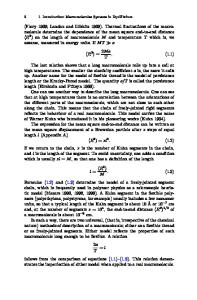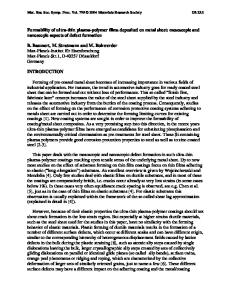Mesoscopic study of the electronic properties of thin polymer films
- PDF / 221,677 Bytes
- 6 Pages / 612 x 792 pts (letter) Page_size
- 2 Downloads / 307 Views
M8.36.1
Mesoscopic study of the electronic properties of thin polymer films Ricardo M. Ribeiro, Marta M. D. Ramos, A. M. Almeida, Helena M. G. Correia, Jaime Silva, A. M. Stoneham1 Departamento de Física, Universidade do Minho, Campus de Gualtar, 4710-057 Braga, Portugal 1 Department of Physics and Astronomy, University College London, Gower Street, London WC1E 6BT, UK ABSTRACT Conjugated polymers are very interesting for light emitting diodes. Further improvement in device performance requires a better understanding on the correlation between the polymer structure and device characteristics. A mesoscopic study using a generalised Monte Carlo method of bipolar charge transport in thin poly(p-phenylene-vinylene) (PPV) films is presented in this paper. We show that energy and spatial molecular disorder have a serious influence on migration of charge carriers within the polymer layer. The transfer of carriers between two polymer chains is made dependent on the chemical potential difference as well as on other features such as the distance between both molecules involved and the direction of the electric field. The purpose of the present work is to clarify the effects of local energy and polymer structural disorder on current flow, trapping and recombination on polymer based devices. INTRODUCTION Luminescent polymers, such as poly(p-phenylene-vinylene) (PPV) are very promising as active light sources in Light Emitting Diodes (LEDs) [1,2]. Although the field has made great progress in the last decade, their performance is still rather poor. There is therefore considerable potential to improve the performance of semiconducting polymer LEDs. It is not trivial to do so, since the performance of such devices is limited by several interdependent factors [3]. However, higher efficiency requires improvements in charge transport within the polymer layer. The complexity of the charge transport process in the polymeric system arises from hopping between discrete levels localised on each polymer molecule aggravated with a high degree of disorder in many polymers. Our earlier work [4-9] suggests that a mesoscopic modelling, which works at an intermediate scale between atomic and macroscopic scale, is an adequate technique for the study of such phenomena if it includes information about intramolecular mobility of charge induced defects, molecular energy levels and nearest neighbour intermolecular distance. Our emphasis in this paper is on the modelling at microscopic length scale: how can the ensemble of polymer molecules with the right electronic properties be organised to optimise device performance. Our aim is to produce several realisations of PPV networks and to carry out computer experiments in which bipolar charge carriers are injected in the polymer system from the appropriate electrodes. The properties of each PPV molecule are obtained from selfconsistent quantum molecular dynamics calculations. In the calculations we report here, the trapping of charge, the percolation in charge transport, the recombination and the effects
Data Loading...











